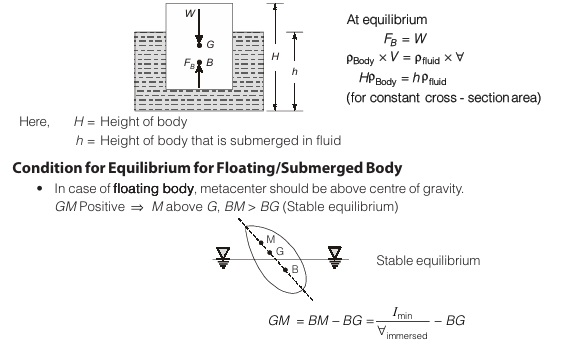Buoyancy and Floatation
Archimedes Principle
When a body is submerged either fully or partially, then it is acted upon by a force of buoyancy vertically up which is equal to weight of liquid displaced by the body.
Remember:
- This force of buoyancy always acts through the centroid of liquid displaced.
- Centre of buoyancy is that point through which buoyant force acts.
Principal of Flotation

For neutral equilibrium, GM = 0, ‘M’ coincides with ‘G’.
For unstable equilibrium, GM < 0, ‘G’ is above ‘M’ for floating body.
In case of submerged body, center of buoyancy should be above centre of gravity.
⇒ B above G (Stable equilibrium), G above B (unstable equilibirum) G and B coincide (neutral equilibrium).
Distance between metacenter and centre of buoyancy (BM) = Imin/ Vimmersed (Metacentric radius)
Here,
Imin=Moment of inertia of top view of floating body about longitudinal axis
V=Volume of body immersed in liquid
Surface Tension/Pressure Inside Drop, Bubble and Jet
Surface tension occurs at the interface of liquid and a gas or at the interface of two liquids. Surface tension is inversely proportional to temperature and it also acts when fluid is at rest.
- Liquid tends to minimize its surface area and hence the surface energy.
- Excess pressure inside drop (Solid like sphere)
- ΔP = = 4σ/d
- Excess pressure inside bubble
- ΔP = = 8σ/d

